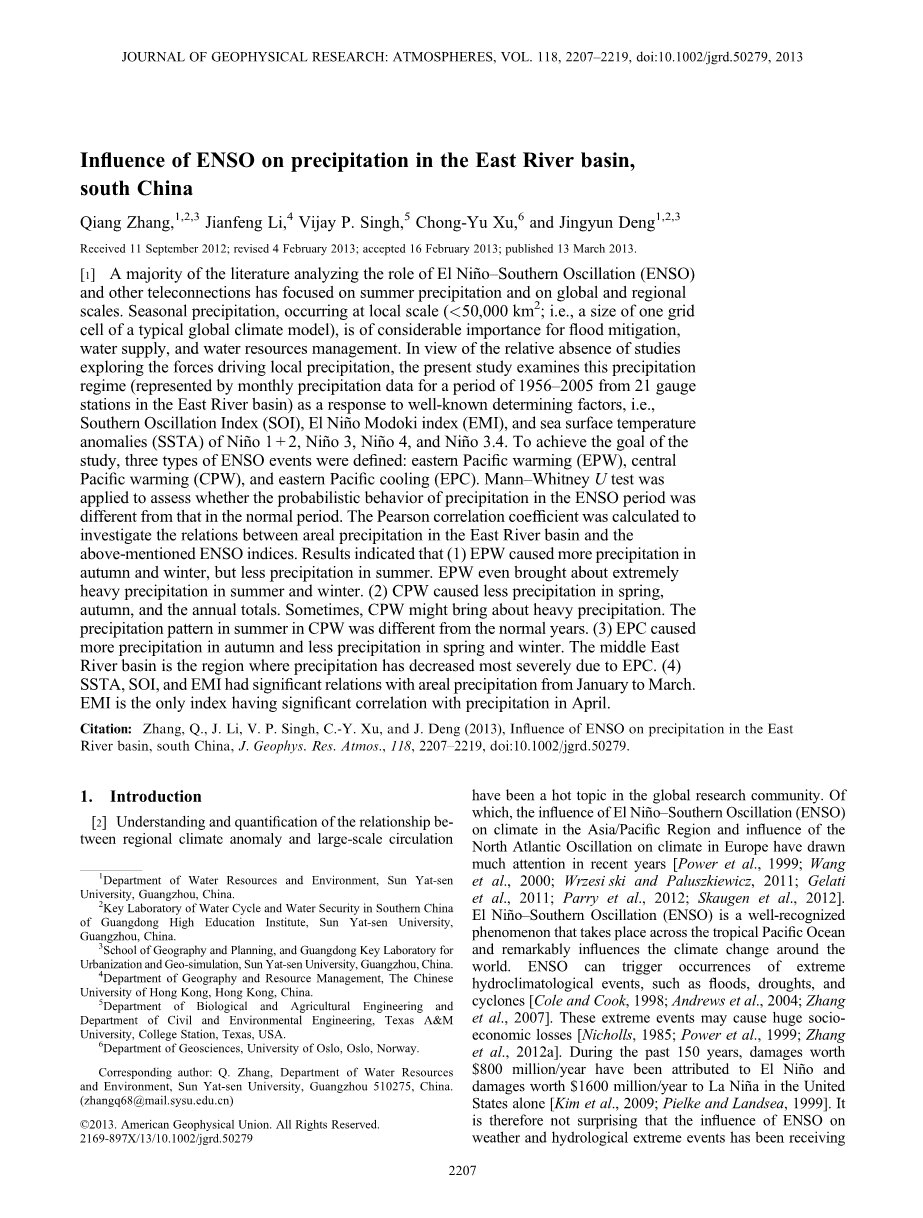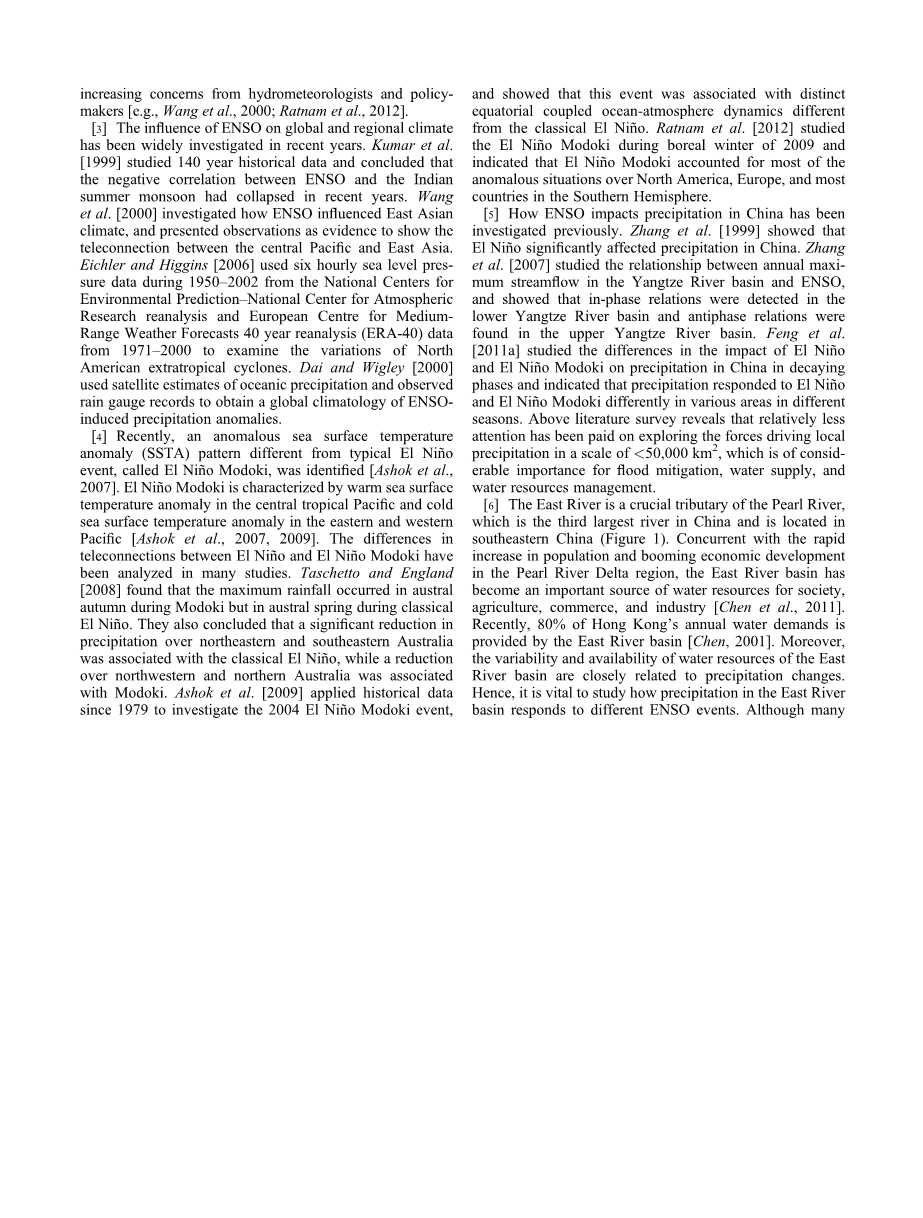不同类型ENSO事件对中国东部夏季降水的影响外文翻译资料
2022-11-24 15:11:18


英语原文共 13 页,剩余内容已隐藏,支付完成后下载完整资料
目 录
1引言hellip;hellip;hellip;hellip;hellip;hellip;hellip;hellip;hellip;hellip;hellip;hellip;hellip;hellip;hellip;hellip;hellip;hellip;hellip;hellip;hellip;hellip;hellip;hellip;hellip;hellip;hellip;hellip;hellip;hellip;hellip;hellip;hellip;hellip;3
2数据hellip;hellip;hellip;hellip;hellip;hellip;hellip;hellip;hellip;hellip;hellip;hellip;hellip;hellip;hellip;hellip;hellip;hellip;hellip;hellip;hellip;hellip;hellip;hellip;hellip;hellip;hellip;hellip;hellip;hellip;hellip;hellip;hellip;hellip;4
3方法hellip;hellip;hellip;hellip;hellip;hellip;hellip;hellip;hellip;hellip;hellip;hellip;hellip;hellip;hellip;hellip;hellip;hellip;hellip;hellip;hellip;hellip;hellip;hellip;hellip;hellip;hellip;hellip;hellip;hellip;hellip;hellip;hellip;hellip;4
3.1 Mann Whitney U检验hellip;hellip;hellip;hellip;hellip;hellip;hellip;hellip;hellip;hellip;hellip;hellip;hellip;hellip;hellip;hellip;hellip;hellip;hellip;hellip;hellip;hellip;hellip;hellip;hellip;hellip;4
3.2 皮尔森相关系数hellip;hellip;hellip;hellip;hellip;hellip;hellip;hellip;hellip;hellip;hellip;hellip;hellip;hellip;hellip;hellip;hellip;hellip;hellip;hellip;hellip;hellip;hellip;hellip;hellip;hellip;hellip;hellip;4
3.3 降水异常指数hellip;hellip;hellip;hellip;hellip;hellip;hellip;hellip;hellip;hellip;hellip;hellip;hellip;hellip;hellip;hellip;hellip;hellip;hellip;hellip;hellip;hellip;hellip;hellip;hellip;hellip;hellip;hellip;hellip;5
4结果hellip;hellip;hellip;hellip;hellip;hellip;hellip;hellip;hellip;hellip;hellip;hellip;hellip;hellip;hellip;hellip;hellip;hellip;hellip;hellip;hellip;hellip;hellip;hellip;hellip;hellip;hellip;hellip;hellip;hellip;hellip;hellip;hellip;hellip;5
4.1 在不同ENSO年月降水量分布hellip;hellip;hellip;hellip;hellip;hellip;hellip;hellip;hellip;hellip;hellip;hellip;hellip;hellip;hellip;hellip;hellip;hellip;hellip;hellip;hellip;hellip;5
4.2 季节性降雨异常hellip;hellip;hellip;hellip;hellip;hellip;hellip;hellip;hellip;hellip;hellip;hellip;hellip;hellip;hellip;hellip;hellip;hellip;hellip;hellip;hellip;hellip;hellip;hellip;hellip;hellip;hellip;hellip;5
4.3 不同ENSO年四季降水量的空间变异hellip;hellip;hellip;hellip;hellip;hellip;hellip;hellip;hellip;hellip;hellip;hellip;hellip;hellip;hellip;hellip;hellip;hellip;hellip;6
4.4 ENSO指数和区域降水的相关系数hellip;hellip;hellip;hellip;hellip;hellip;hellip;hellip;hellip;hellip;hellip;hellip;hellip;hellip;hellip;hellip;hellip;hellip;hellip;hellip;hellip;7
5讨论hellip;hellip;hellip;hellip;hellip;hellip;hellip;hellip;hellip;hellip;hellip;hellip;hellip;hellip;hellip;hellip;hellip;hellip;hellip;hellip;hellip;hellip;hellip;hellip;hellip;hellip;hellip;hellip;hellip;hellip;hellip;hellip;hellip;hellip;hellip;8
6结论hellip;hellip;hellip;hellip;hellip;hellip;hellip;hellip;hellip;hellip;hellip;hellip;hellip;hellip;hellip;hellip;hellip;hellip;hellip;hellip;hellip;hellip;hellip;hellip;hellip;hellip;hellip;hellip;hellip;hellip;hellip;hellip;hellip;hellip;hellip;10
7参考文献hellip;hellip;hellip;hellip;hellip;hellip;hellip;hellip;hellip;hellip;hellip;hellip;hellip;hellip;hellip;hellip;hellip;hellip;hellip;hellip;hellip;hellip;hellip;hellip;hellip;hellip;hellip;hellip;hellip;hellip;hellip;hellip;10
ENSO对华南的东部流域的降水影响
Qiang Zhang,Jianfeng Li,Vijay P.Singh,Chong-Yu Xu,and Jingyun Deng
2012年9月11号被接受;2013年2月4号修改;2013年2月16号被接受;2013年3月13号
[1]大多数文献对厄尔尼诺-南方涛动(ENSO)的作用和其他遥相关的分析都集中在夏季降水和全球或者区域尺度。季节性降水,是发生在当地的规模(小于50000平方公里,即一个典型的全球气候模型的一个网格单元的大小),对缓解洪水,供应水资源以及水资源管理非常重要。鉴于对探索当地降水的驱动力的研究较少,本研究探讨这个降水制度(表现为每月的降水数据为1956,21,从2005规范的一段时间站在河东流域)作为一种对知名的决定因素反应,即,南方涛动指数(SOI),厄尔尼诺Modoki指数(EMI),海表面温度异常(SSTA)厄尔尼诺 1 2区,厄尔尼诺3区、厄尔尼诺4区、厄尔尼诺3.4区。为了达到研究的目的,定义了三种类型的事件:东太平洋变暖(EPW)、中太平洋变暖(CPW)和东太平洋变冷(EPC)。Mann-Whitney U检验用来评估是否在ENSO期间与正常时期的降水概率是不同的。皮尔森相关系数的计算结果是用来研究东河流域雨量和上述ENSO指数之间的关系。 结果表明:EPW引起秋冬季降水较多,但夏季少雨。EPW甚至带来了极强的夏季和冬季强降水。CPW在春天,秋天造成少量降水,每年降水总数。有时,CPW可能带来强降水,导致夏季降水模式不同于正常年。EPC导致秋季降水多,春季和冬季降水少。中东河流域地区降水由于EPC最严重下降。(4)SSTA,SOI,和EMI对1月到3月区域降水量有显著关系。EMI是唯一的与四月降水量有显著相关性的指数。
Influence of ENSO on precipitation in the East River basin,south China
Qiang Zhang, 1,2,3 Jianfeng Li, 4 Vijay P. Singh, 5 Chong-Yu Xu, 6 and Jingyun Deng 1,2,3
Received 11 September 2012; revised 4 February 2013; accepted 16 February 2013; published 13 March 2013.
Abstract:[1] A majority of the literature analyzing the role of El Nintilde;o–Southern Oscillation (ENSO) and other teleconnections has focused on summer precipitation and on global and regional scales. Seasonal precipitation, occurring at local scale (lt;50,000 km 2 ; i.e., a size of one grid cell of a typical global climate model), is of considerable importance for flood mitigation,water supply, and water resources management. In view of the relative absence of studies exploring the forces driving local precipitation, the present study examines this precipitation regime (represented by monthly precipitation data for a period of 1956–2005 from 21 gauge stations in the East River basin) as a response to well-known determining factors, i.e., Southern Oscillation Index (SOI), El Nintilde;o Modoki index (EMI), and sea surface temperature anomalies (SSTA) of Nintilde;o 1 2, Nintilde;o 3, Nintilde;o 4, and Nintilde;o 3.4. To achieve the goal of the study, three types of ENSO events were defined: eastern Pacific warming (EPW), central Pacific warming (CPW), and eastern Pacific cooling (EPC). Mann–Whitney U test was applied to assess whether the probabilistic behavior of precipitation in the ENSO period was different from that in the normal period. The Pearson correlation coefficient was calculated to investigate the relations between areal precipitation in the East River basin and the above-mentioned ENSO indices. Results indicatedthat (1) EPW caused moreprecipitation in autumn and winter, but less precipitation in summer. EPW even brought about extremely heavy precipitation in summer and winter. (2) CPW caused less precipitation in spring, autumn, and the annual totals. Sometimes, CPW might bring about heavy precipitation. The precipitation pattern in summer in CPW was different from the normal years. (3) EPC caused more precipitation in autumn and less precipitation in spring and winter. The middle East River basin is the region where precipitation has decreased most severely due to EPC. (4) SSTA, SOI, and EMI had significant relations with areal precipitation from January to March.EMI is the only index having significant correlation with precipitation in April.
Citation: Zhang, Q., J. Li, V. P. Singh, C.-Y. Xu, and J. Deng (2013), Influence of ENSO on precipitation in the East River basin, south China, J. Geophys. Res. Atmos., 118, 2207–2219, doi:10.1002/jgrd.50279.
1.引言
[2]理解和量化区域气候异常与大尺度环流之间的关系,一直是全球研究界的热门话题。其中,ENSO的影响在亚洲/太平洋地区的气候以及对欧洲的北大西洋涛动在气候上的影响,近年来已经备受关注。[Power等人,1999;Wang等人,2000;Wrzesi ski和paluszkiewicz,2011;Gelati等人,2011;Parry等人.,2012;Skaugen等人,2012]。ENSO是一个公认的现象,它穿越热带太平洋,而且显著地影响了世界的气候变化。ENSO可以触发事件的极端水文事件,如洪水、干旱、和旋风[Cole和Cook,1998;Andrews等,2004;Zhang等,2007。这些极端事件可能会导致巨大的社会经济损失[Nicholls,1985,Power等,1999;Zhang等人,2012A]。在过去的150年中,仅在美国,每年就因厄尔尼诺造成损失8亿美元,因拉尼娜造成损失16亿美元。[Kim等人,2009;Pielke and Landsea,1999]。因此,毫不奇怪,ENSO的影响天气和水文极端事件已受到水文学家到政策制定者们越来越多的担忧。[例如,Wang等人,2000;Ratnam等人,2012]。
[3]近年来ENSO对全球和区域气候的影响已被广泛研究。库马尔等[1999],研究了140年的历史数据,并得出结论:ENSO和印度夏季风之间的负相关关系近几年已失效。王等[2000],研究了ENSO如何影响东亚气候,并提出意见作为证据显示环太平洋和东亚之间的遥相关。Eichler和Higgins [2006]用国家气候预测中心的1950到2002年的六小时海平面气压数据、国家大气研究中心的再分析数据以及欧洲中心中尺度天气预报所的从1971至2000年这40年来的再分析数据,来研究北美的变化的温带气旋。Dai和Wigley[2000]利用卫星对海洋降水的估计和观测雨量计记录获得由ENSO诱导的全球气候降水异常。
[4]最近,一种不同于典型的厄尔尼诺事件,反常的海表温度异常(SSTA)模式,被称为厄尔尼诺Modoki,被定义。[Ashok等人,2007]。厄尔尼诺Modoki的特点是热带太平洋地区海洋表面为热的温度异常,东西太平洋地区为冷的温度异常。[Ashok等人,2007,2009]。厄尔尼诺和厄尔尼诺Modoki的差异在许多研究中被分析。Taschetto和England[2008]发现,在澳大利亚,在modoki时期最大降雨发生在春天,在经典厄尔尼诺时期最大降水发生在春天。他们还得出结论,澳大利亚东北部和东南部显著减少的降水与经典的厄尔尼诺有关,而西北部和北部和Modoki有关。Ashok等人。[2009]运用1979年以来的历史数据来调查2004的厄尔尼诺Modoki事件,结果显示,这一事件与不同的赤道耦合海洋大气动力学有关,不同于经典的厄尔尼诺。Ratnam等人[2012],研究2009年北方冬天的厄尔尼诺Modoki,结果表明厄尔尼诺Modoki导致了大多数的北美国,欧洲,和大多数南半球的城市的异常情况。
[5]ENSO如何影响中国降水已经被调查很久。Zhang等[1999],显示厄尔尼诺显著影响中国降水。Zhang等[2007],研究了扬子江流域的主支流和ENSO之间的年际关系,结果显示在扬子江流域下游和ENSO是正相变化,而扬子江流域上游和ENSO是反向变化。Feng等人[2011A],研究了厄尔尼诺和厄尔尼诺Modoki在下降阶段对中国降水的的影响的差异,结果显示降水在大部分地区的不同季节,与厄尔尼诺和厄尔尼诺modoki的关系是不同的。
上述文献的调查显示,对探索驱动当地约50000平方公里的对缓解洪水、水资源供应和水资源的管理有重要意义的规模的降水相对较少。
[6]这条河是珠江的重要支流,这是中国的第三大河流,位于中国东南(图1)。在珠江三角洲地区,与人口增长的快速和经济发展的繁荣同时发生的,是东河流域成为社会水资源、农业、商业、工业的重要来源[Chen等,2011]。近年来,香港每年80%的用水需求都由东河流域提供[Chen,2001]。而且,东部水资源的变异性和可利用性与降水变化密切相关。因此,研究如何在东部河流域对不同ENSO事件的响应是非常重要的。
剩余内容已隐藏,支付完成后下载完整资料
资料编号:[30029],资料为PDF文档或Word文档,PDF文档可免费转换为Word




